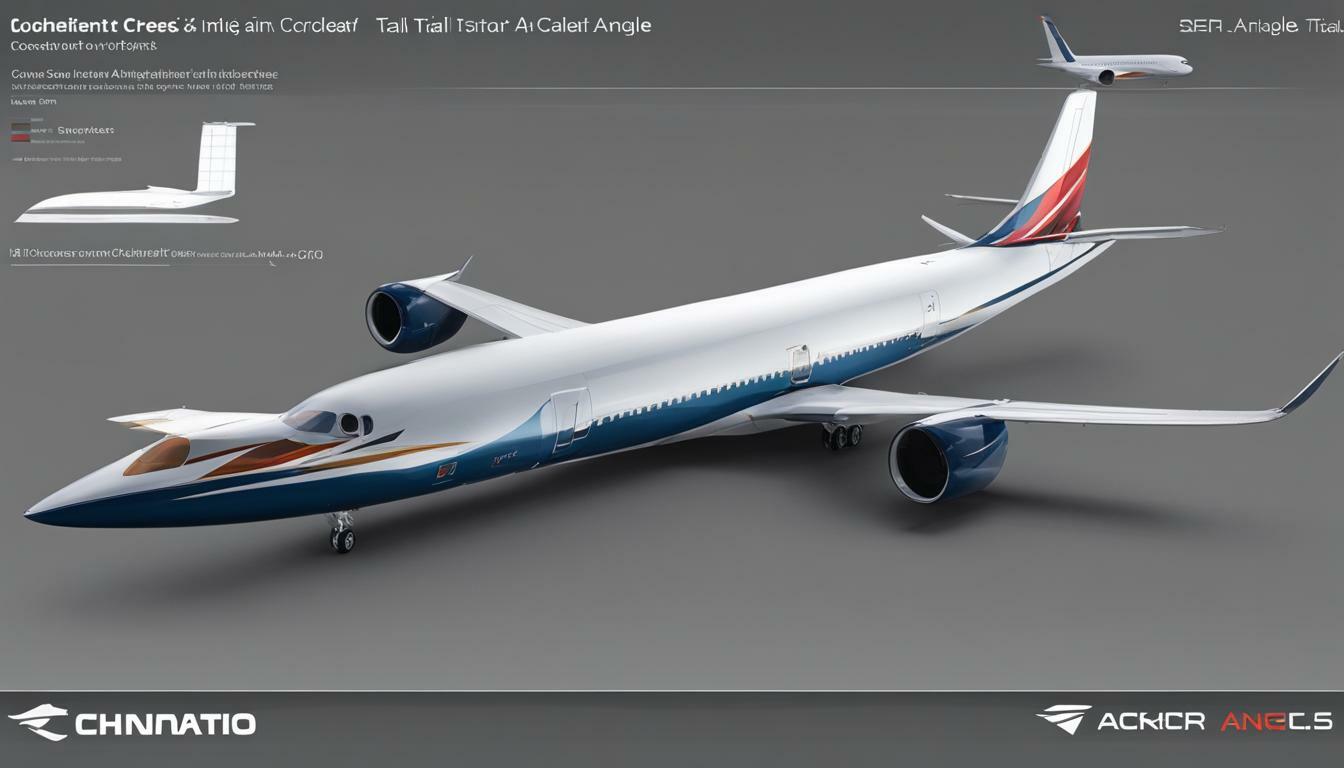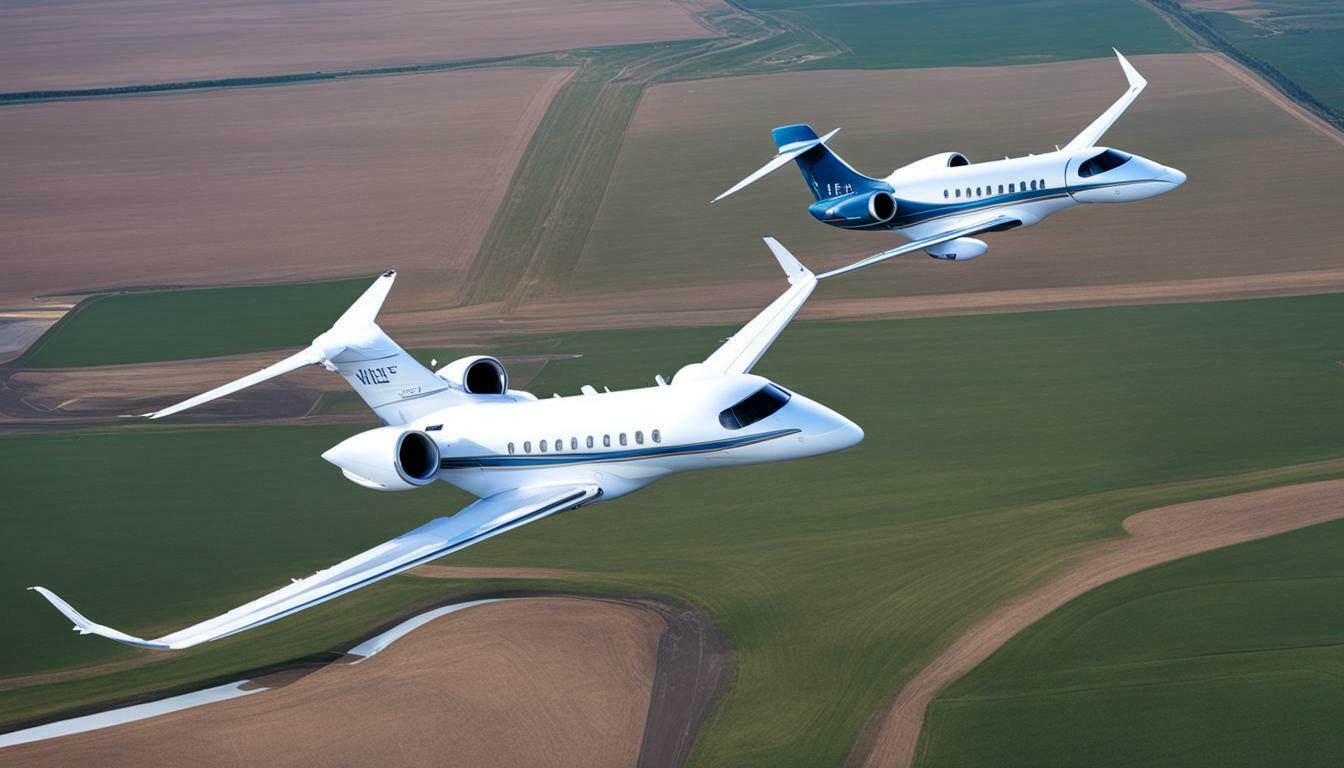When it comes to aircraft design, one important factor to consider is the tail configuration, which can significantly impact the aircraft’s performance and handling. The main difference between a T-tail and a conventional tail on an aircraft is the position of the horizontal stabilizer. In a T-tail configuration, the horizontal stabilizer is mounted on top of the vertical fin, forming a T shape. This design is often found on aircraft with engines mounted on the rear of the fuselage or on high-winged aircraft, as it keeps the tail clear of the jet exhaust. T-tails can provide better short-field performance and elevator response. However, there are some drawbacks to T-tails, including the risk of deep stall at high angles of attack and maintenance challenges. Conventional tails, on the other hand, are easier to install and maintain, but may have lower elevator response in disturbed airflow conditions.
Key Takeaways:
- T-tail aircraft have their horizontal stabilizer mounted on top of the vertical fin, forming a T shape.
- Conventional tail aircraft have their horizontal stabilizer positioned below the vertical fin.
- T-tail configuration is commonly found on aircraft with rear-mounted engines or high-winged aircraft.
- T-tails can provide better short-field performance and elevator response.
- However, T-tails can also present challenges such as a higher risk of deep stall and maintenance difficulties.
- Conventional tails are easier to install and maintain but may have lower elevator response in disturbed airflow conditions.
T-Tail Aircraft Characteristics
T-tail aircraft, characterized by the horizontal stabilizer mounted on top of the vertical fin, offer distinct advantages in specific aviation scenarios. This unique tail configuration is often found on aircraft with engines mounted on the rear of the fuselage or high-winged aircraft, as it keeps the tail clear of the jet exhaust. The T-tail design provides several benefits, including improved short-field performance and elevator response.
One advantage of T-tail aircraft is their ability to perform well in short-field operations. The position of the horizontal stabilizer at the top of the vertical fin allows for more effective control during takeoff and landing, particularly when operating on shorter runways. This enhanced control enables pilots to safely maneuver the aircraft, ensuring a smooth and efficient performance in confined spaces.
In addition to short-field performance, T-tail aircraft also exhibit superior elevator response. The placement of the horizontal stabilizer at the top of the vertical fin allows for increased leverage, resulting in more precise control of the elevator. This enhanced responsiveness allows pilots to make quick and accurate adjustments to the aircraft’s pitch, contributing to improved handling and maneuverability.
Table: T-Tail Aircraft Advantages
| Advantages |
|---|
| Improved short-field performance |
| Superior elevator response |
While T-tail aircraft offer these advantages, it is important to note that they also have some drawbacks. One such concern is the risk of deep stall at high angles of attack. In certain flight conditions, T-tail aircraft can experience a loss of lift on the horizontal stabilizer, leading to an uncontrollable descent. Pilots must be aware of this potential issue and take appropriate measures to prevent deep stalls, such as maintaining safe speeds and avoiding excessive pitch angles.
Maintenance challenges can also arise with T-tail aircraft due to the positioning of the horizontal stabilizer. Accessing and inspecting the tail components can be more difficult compared to conventional tail aircraft. This may result in increased maintenance time and costs, as well as the need for specialized tools or equipment. However, with proper maintenance procedures and regular inspections, these challenges can be effectively managed to ensure the continued airworthiness of T-tail aircraft.
Conventional Tail Aircraft Characteristics
Conventional tail aircraft, featuring a horizontal stabilizer mounted at the rear of the fuselage, have their own unique set of traits and advantages. This tail configuration is commonly found on a wide range of aircraft, from small propeller-driven planes to large commercial jets. The positioning of the horizontal stabilizer at the rear allows for increased stability and control during flight.
One of the key advantages of conventional tails is their ease of installation and maintenance. With the horizontal stabilizer located at the back of the aircraft, it is more accessible for routine inspections and repairs. This can significantly reduce downtime and maintenance costs compared to other tail configurations.
In addition, conventional tails tend to perform better in disturbed airflow conditions. The position of the horizontal stabilizer allows it to remain in relatively undisturbed air, which helps maintain stability and control, especially during maneuvers or in turbulent weather conditions.
While conventional tails offer these advantages, it is worth noting that they may have lower elevator response compared to T-tail configurations. Elevator response refers to the effectiveness and speed of the elevators in controlling the pitch of the aircraft. In some cases, this can result in slightly reduced maneuverability during certain flight scenarios.
| Advantages | Disadvantages |
|---|---|
| Easy installation and maintenance | Lower elevator response in disturbed airflow conditions |
| Good stability and control |
“The conventional tail configuration provides stability and control while allowing for easy maintenance, making it a popular choice for a wide range of aircraft.”
Conclusion:
Conventional tail aircraft offer several advantages, including ease of installation and maintenance, as well as good stability and control. While they may have lower elevator response in disturbed airflow conditions compared to other tail configurations, the conventional tail remains a popular choice for many aircraft due to its reliability and accessibility for maintenance.
Comparison Between T-Tail and Conventional Tail Aircraft
By comparing the features and characteristics of T-tail and conventional tail aircraft, we can gain a better understanding of their differences and suitability for various aviation scenarios.
T-tail aircraft, with their horizontal stabilizer positioned on top of the vertical fin, offer distinct advantages. This design is commonly seen on aircraft with engines mounted at the rear or high-winged aircraft, as it prevents the tail from being obstructed by jet exhaust. One of the key benefits of T-tails is their improved short-field performance, allowing for better takeoff and landing in limited runway environments. Additionally, T-tail aircraft typically exhibit more responsive elevator control, making them well-suited for precision maneuvers.
However, T-tail aircraft also come with certain drawbacks. One such concern is the risk of experiencing a deep stall at high angles of attack. This occurs when the airflow over the wing is disrupted, resulting in reduced lift and potential loss of control. To mitigate this risk, pilots must be trained to recognize and respond effectively to such situations. Another challenge associated with T-tail aircraft is maintenance. Due to the elevated position of the horizontal stabilizer, accessing and servicing components can be more complex and time-consuming.
Conventional tail aircraft, on the other hand, have their horizontal stabilizer mounted on the fuselage in a more traditional configuration. While this setup may offer less favorable short-field performance compared to T-tail aircraft, conventional tails are generally easier to install and maintain. The lower positioning of the horizontal stabilizer allows for simpler access to components, reducing maintenance time and costs. However, conventional tails may exhibit lower elevator response in disturbed airflow conditions, which can impact their performance in certain scenarios.
| Comparison | T-Tail Aircraft | Conventional Tail Aircraft |
|---|---|---|
| Short-Field Performance | Superior | Less favorable |
| Elevator Response | More responsive | Potentially lower |
| Risk of Deep Stall | Possible | N/A, as deep stall is specific to T-tail configuration |
| Maintenance Challenges | More complex | Less complex |
In conclusion, T-tail and conventional tail aircraft have distinct characteristics and advantages. T-tail aircraft excel in short-field performance and provide responsive elevator control, making them suitable for specific aviation scenarios. However, the risk of deep stall and maintenance challenges should be considered. Conventional tail aircraft offer easier installation and maintenance processes, but may have limitations in elevator response. Understanding these differences allows pilots and aviation professionals to make informed decisions based on the specific requirements of their operations.
Conclusion
In conclusion, the choice between T-tail and conventional tail aircraft depends on factors such as engine placement, aircraft type, and desired performance characteristics. Understanding the differences and advantages of each tail configuration is crucial for informed decision-making in the field of aviation.
The main difference between a T-tail and a conventional tail on an aircraft is the position of the horizontal stabilizer. In a T-tail configuration, the horizontal stabilizer is mounted on top of the vertical fin, forming a T shape. This design is often found on aircraft with engines mounted on the rear of the fuselage or on high-winged aircraft, as it keeps the tail clear of the jet exhaust.
T-tails can provide better short-field performance and elevator response. However, there are some drawbacks to T-tails, including the risk of deep stall at high angles of attack and maintenance challenges. Conventional tails, on the other hand, are easier to install and maintain but may have lower elevator response in disturbed airflow conditions.
Informed decision-making in aircraft design and operation requires a thorough understanding of the advantages and disadvantages of different tail configurations. Whether it’s a T-tail or a conventional tail, each offers unique benefits that can be optimized for specific aircraft and operational requirements. By considering the factors mentioned earlier, aviation professionals can make informed choices to enhance safety, performance, and efficiency in their operations.
FAQ
What is the main difference between a T-tail and a conventional tail on an aircraft?
The main difference is the position of the horizontal stabilizer. In a T-tail configuration, the horizontal stabilizer is mounted on top of the vertical fin, forming a T shape.
Why are T-tails often found on aircraft with rear-mounted engines or high-winged aircraft?
T-tails are often used on these types of aircraft because they keep the tail clear of the jet exhaust. This design choice provides better short-field performance and elevator response.
What are some drawbacks of T-tails?
Some drawbacks of T-tails include the risk of deep stall at high angles of attack and maintenance challenges.
Are conventional tails easier to install and maintain compared to T-tails?
Yes, conventional tails are generally easier to install and maintain, but they may have lower elevator response in disturbed airflow conditions.



